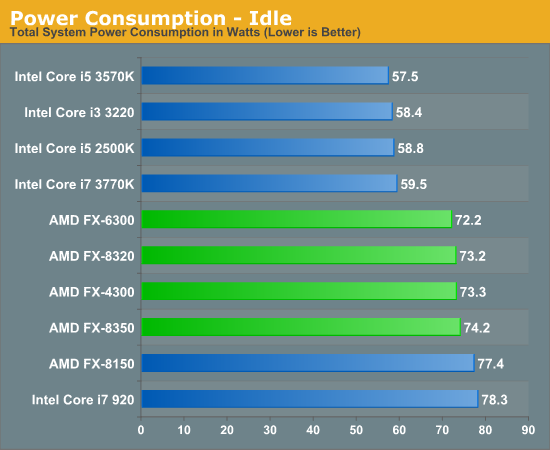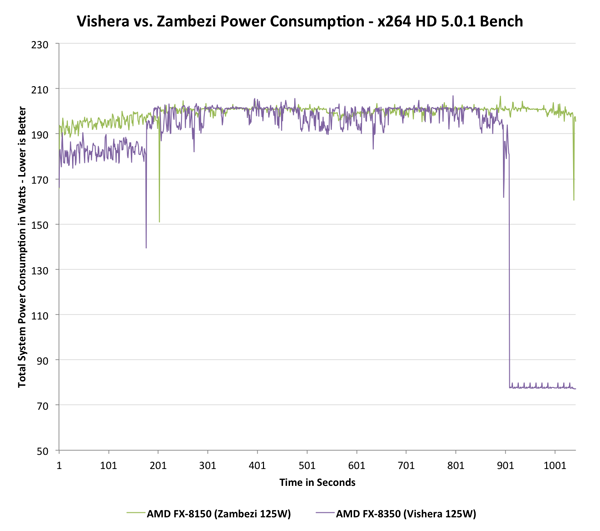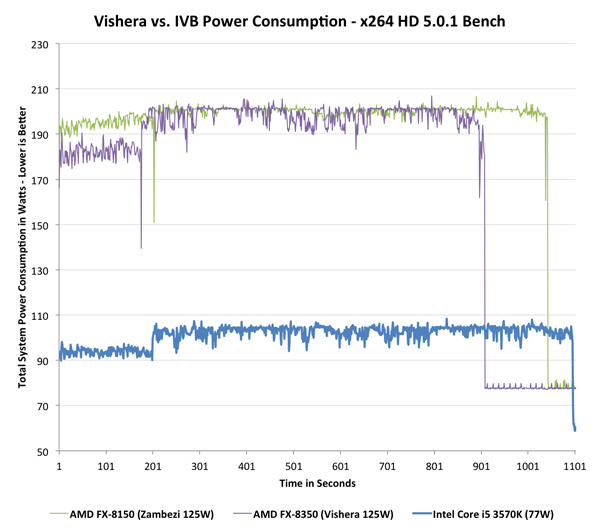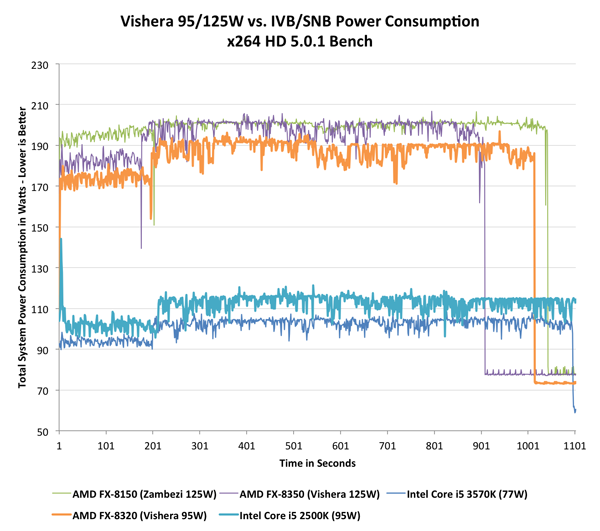The Vishera Review: AMD FX-8350, FX-8320, FX-6300 and FX-4300 Tested
by Anand Lal Shimpi on October 23, 2012 12:00 AM ESTPower Consumption
With Vishera, AMD was in a difficult position: it had to drive performance up without blowing through its 125W TDP. As the Piledriver cores were designed to do just that, Vishera benefitted. Remember that Piledriver was predominantly built to take this new architecture into mobile. I went through the details of what makes Piledriver different from its predecessor (Bulldozer) but at as far as power consumption is concerned, AMD moved to a different type of flip-flop in Piledriver that increased complexity on the design/timing end but decreased active power considerably. Basically, it made more work for AMD but resulted in a more power efficient chip without moving to a dramatically different architecture or new process node.
In mobile, AMD used these power saving gains to put Piledriver in mobile APUs, a place where Bulldozer never went. We saw this with Trinity, and surprisingly enough it managed to outperform the previous Llano generation APUs while improving battery life. On desktops however, AMD used the power savings offered by Piledriver to drive clock speeds up, thus increasing performance, without increasing power consumption. Since peak power didn't go up, overall power efficiency actually improves with Vishera over Zambezi. The chart below illustrates total system power consumption while running both passes of the x264 HD (5.0.1) benchmark to illustrate my point:
In the first pass Vishera actually draws a little less power, but once we get to the heavier second encode pass the two curves are mostly indistinguishable (Vishera still drops below Zambezi regularly). Vishera uses its extra frequency and IPC tweaks to complete the task sooner, and drive down to idle power levels, thus saving energy overall. The picture doesn't look as good though if we toss Ivy Bridge into the mix. Intel's 77W Core i5 3570K is targeted by AMD as the FX-8350's natural competitor. The 8350 is priced lower and actually outperforms the 3570K in this test, but it draws significantly more power:
The platforms aren't entirely comparable, but Intel maintains a huge power advantage over AMD. With the move to 22nm, Intel dropped power consumption over an already more power efficient Sandy Bridge CPU at 32nm. While Intel drove power consumption lower, AMD kept it constant and drove performance higher. Even if we look at the FX-8320 and toss Sandy Bridge into the mix, the situation doesn't change dramatically:
Sandy Bridge obviously consumes more than Ivy Bridge, but the gap between a Vishera and any of the two Intel platforms is significant. As I mentioned earlier however, this particular test runs quicker on Vishera however the test would have to be much longer in order to really give AMD the overall efficiency advantage.
If we look at average power over the course of the two x264 encode passes, the results back up what we've seen above:

As more client PCs move towards smaller form factors, power consumption may become just as important as the single threaded performance gap. For those building in large cases this shouldn't be a problem, but for small form factor systems you'll want to go Ivy Bridge.
Note that idle power consumption can be competitive, but will obviously vary depending on the motherboard used (the Crosshair Formula V is hardly the lowest power AM3+ board available):














250 Comments
View All Comments
CeriseCogburn - Tuesday, October 30, 2012 - link
You simpletons all have the same hate filled idiot theory - so let me ask you - since amd has competition, WHY DO THEY SUCK SO BADLY ?Somehow you idiots claim, that if amd wasn't around, intel would suck. "Amd has made intel great"
Well, wait a minute - Intel is around, it's great, AND AMD SUCKS.
Take a moment, look in the mirror, think about it.... then let me know how red you turned... if not at all, contraception from here on out is a must.
How are you people so stupid ? How is it possible ?
Ukdude21 - Thursday, August 15, 2013 - link
You the biggest idiot on this website. I have read many comments on this website but yours are the most idiotic intel fanboy stained comments ever.halbhh2 - Thursday, October 25, 2012 - link
If power use is important to you, you should know that different reviews give different results for the power use vs competing intel chips.A couple of sites even have equal or lower idle power draw for the 8350 vs i7 3770.
Trying to figure out why, one variable is the motherboard. Is the Crosshair V a power hog?
I also looked at yearly cost in electrical use for my own useage.
The only thing I do that pegs multiple cores at 100% is chess analysis. In Deep Fritz the 8350 is close in performance to the i7 3770.
I do chess analysis about 1-5 hours a week on average, perhaps 200 hours per year.
The math is very simple. Power costs 16 cents per kilowatt hour. Peak power useage would cost an extra $3/year roughly vs an intel rig for me. Since I'd use a more power efficient motherboard than the Asus Crosshair, idle power is reasonable. I standby a lot when not using also.
An 8350 would cost me in the range of $4-$8 more per year in power bills vs an i7 3770 (it's competitor for chess analysis).
CeriseCogburn - Tuesday, October 30, 2012 - link
So go ahead and destroy the earth, see if any humans care.Ukdude21 - Thursday, August 15, 2013 - link
If you are the worried about the earth why don't you give your pc away. Least then we would not have to read your shit comments lol.taltamir - Thursday, October 25, 2012 - link
Starting the power cosumption graphs at 50 watt instead of 0 watt is GROSSLY MISLEADING! and very unfair to AMD.Lack of performance per watt comparison is unfair to Intel. Yea, AMD finally is able to, at stock, beat intel on some benchmarks... But they consume significantly more power to do so (intel could easily start selling higher clocked parts too)
pcfxer - Thursday, October 25, 2012 - link
If I ever build a new machine...it looks like I'll swing towards my first ever Intel box...hrmmm the anticipation may make me do it just for fun even though my Phenom II X555BE Unlocked and OC'd to 3.5GHz serves me just fine.OCedHrt - Friday, October 26, 2012 - link
it would be nice if they were normalized to idle power usage since we are comparing CPU power usage.halbhh2 - Friday, October 26, 2012 - link
I got curious about the idle power and visited 7 sites to look at reviews. No 2 sites had the same idle power difference between the 8350 vs the i7 3770. Values ranged from 9 watts AMD *lower* (lower! than intel) to 22 watts higher. The higher readings seemed to all be with the Asus Crosshair V, which logically must be a power hog.You should consider the idle power numbers *not* representative. Unreliable.
danrien - Monday, October 29, 2012 - link
Seems like its server opteron cousin would be kick-ass.